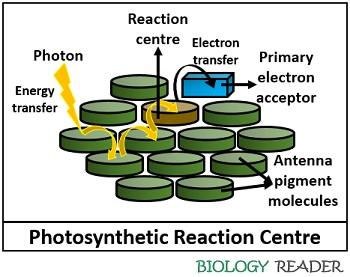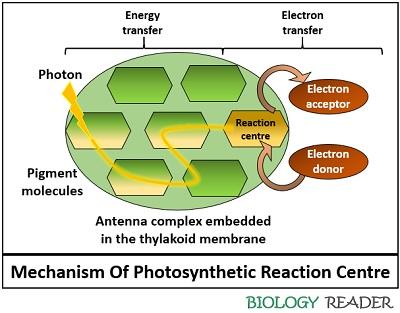Reaction centre refers to the site of photosynthetic reactions. Chlorophyll and pheophytin are the pigments found in a reaction centre. It comprises protein pigments that mediates light absorption and excitation of an electron to the higher energy state.
Photosynthetic organisms like green plants, many bacteria and algae have membrane-bound protein complexes or reaction centres that execute a transmembrane electron transfer. Photosystem I and II are the two common RCs of green plants and algae.
A reaction centre includes a multisubunit protein complex, which makes its structure more complex. Besides proteins, it includes light-harvesting pigments and cofactors that execute light reaction photosynthesis.
RC captures light energy for exciting electrons to a higher state to release free energy. Later, the photosynthetic cells utilize free energy to reduce an electron acceptor into chemical energy, i.e. ATP and NADPH.
Photosynthetic cells further utilize ATP to produce sugars as the final product of photosynthesis by fixing atmospheric carbon dioxide. This post describes the definition, mechanism, reaction centre of photosystem 1 and 2, along with the structure and types.
Content: Reaction Centre
Definition
A reaction centre is the active site of the organisms, which carries out photosynthesis by converting light energy into chemical form via the association of accessory pigment proteins or antenna molecules. The photosynthetic organisms use either of the two photosystems (PS-I or PS-II) or both to carry out the light absorption, electron transfer and release of free energy. The photosystem is a basic component of the light reaction.
- In plants and algae, photosystems are located within the chloroplasts.
- In photosynthetic bacteria, the photosystem is found in the bilayer cell membrane.

A reaction centre lies within the photosystems, which reduce the carrier molecules using light energy. Light-harvesting pigments surround the RC, which altogether contributes to an antenna complex that mediates light absorption and transfer of photons to charge the reaction centre. The difference between photosystem I and photosystem II classifies RCs primarily into two significant groups:
- Type I RCs: It includes PS-I (P700).
- Type II RCs: It includes PS-II (P680).
Mechanism of Capturing Light Energy
The arrangement of the reaction centre facilitates capturing of photon molecules through light-harvesting pigment molecules. Firstly, the pigment molecules capture light energy, pass it to the antenna molecules and finally, towards the reaction centre via resonance transfer.
As the light energy reaches the RC, 2e– enter the electron transfer system. Here, light is considered the form of energy because it possesses small bunches of energy termed photons. The photons from the light energy of a specific wavelength excite electrons to a higher energy level.
Electrons are most stable at their ground state. Electrons possess the least amount of energy in their orbit during the ground state. The excited electrons return to the photosystem by releasing some energy. Later, photosynthetic cells harness the free energy to carry out the dark reaction of photosynthesis. Thus, this is the whole mechanism of a photosynthetic reaction centre.
Reaction Centre of PS-I and PS-II
The reaction centre plays a significant role in the photosynthesis of bacteria, cyanobacteria and higher plants. Oxygenic and non-oxygenic photophosphorylation are the two typical modes of photosynthesis.
Cyanobacteria and higher plants carry out oxygenic photosynthesis by using both photosystems I and II. Conversely, photosynthetic bacteria undergo non-oxygenic photosynthesis and use only one photosystem (either PS-I or PS-II). The mechanism of photosynthetic RC involves three consecutive stages:

- Light absorption: The photopigments of the RC primarily absorb light of a specific wavelength.
- Energy transfer: Then, auxillary antenna pigments pass photons or electrons to the reaction centre, after which the photochemical reaction occurs.
- Electron excitation: The charged reaction centre releases high energy electrons by causing electron excitation from the ground to a higher energy state. Primary cofactors like plastoquinone or ferredoxin accept the energized electrons that go through a series of chemical reactions. At last, electrons either go back to the antenna molecules (cyclic photophosphorylation) or enter the PS-I (noncyclic photophosphorylation). The difference between cyclic and noncyclic photophosphorylation is due to the type of photosynthetic process (oxygenic or non-oxygenic) that the organisms go through.
Structure
A reaction centre possesses a multisubunit complex (containing >24 or >33 protein subunits). The RC of the photosynthetic bacteria provides the best way to research the mechanism of light energy absorption by photopigments.
Hartmut Michel, Johann Deisenhofer and Robert Huber were the scientists who proposed the crystal structure of RC. On further study, it was observed that different subunits and few accessory molecules participate in the photosynthetic reaction centre.
Subunits
A bacterial photosynthetic RC comprises distinct subunits as follows:
- L and M subunits are associated with the cell membrane, both are structurally identical, and each possesses 5 transmembrane polypeptide helices. They also contain ferrous ions.
- H subunit is associated with the cytoplasmic side of the cell membrane.
- Cytochrome subunit is associated with the periplasmic space of the cell membrane, and it comprises four c-type hemes.
Pigment Molecules
A bacterial photosynthetic RC comprises the following pigment proteins:
- Four bacteriochlorophyll b (BChl-b) molecules are the primary protein pigments that facilitate energy transfer via photon absorption. Bacteriochlorophylls roughly resemble the plant chlorophyll.
- Two bacteriopheophytin b molecules (BPh) possess more or less the same structure as BChl-b; only 2H+ is present in place of central Mg2+.
- Two quinones (QA and QB) are the cofactor protein molecules.
Types of Reaction Centre
Six kinds of photosynthetic RCs generally exist, depending on the following factors:
- Size and nature of the light-harvesting pigment
- The associated photosystem
- Strength of the reaction centre pigment to excite an electron
Type-I and Type-II RCs are the two major groups:
- Type-I reaction centre: Heliobacteria, green sulfur bacteria, and photosystem-I possesses type-I RC. In this group, the iron-sulfur clusters function as electron acceptors.
- Type-II reaction centre: Purple bacteria, green filamentous bacteria, and photosystem-II possess type-II RC. In this group, quinones act as the primary electron acceptors.
The reaction centre functions as a primary donor that passes the electron to the cofactors or electron acceptors in a photosynthetic reaction. The electron donors generally possess Tyr residue (TyrZ) and comprise the following elements:
- A cluster of 4 manganese ions for PSII
- Plastocyanin molecule for PSI
- Cytochrome-c for the bacterial RCs
The structure and arrangement of the antenna pigments associated with the RC differ variably among different photosynthetic organisms. The RC of heliobacteria possess a simple organization by having a single protein complex (contains 40 chlorophyll g pigments) that lacks auxiliary peripheral antenna proteins.
The RC of photosystem-I and green sulfur bacteria comprises light-harvesting pigments (around 100). In contrast, the RC of purple bacteria and photosystem-II comprises around six to eight pigment proteins having C2 symmetry.